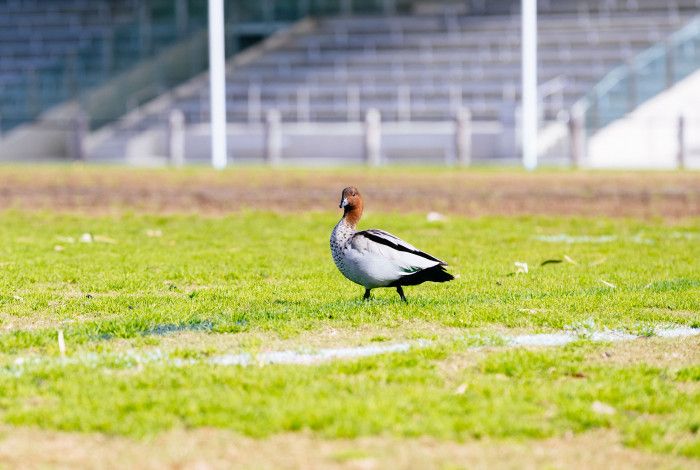In recent months there has been a significant increase in the number of seagulls observed within central Dandenong. The main cause for this increase appears to be the ease of access to food and breeding sites. While seagulls can breed all year round their main breeding season is between July and October each year.
As Seagulls only require 200gsm to survive, limiting the amount of food available (food or food waste) can help control the number of Seagulls. When visiting one of Greater Dandenong’s public places please feed the bins, not the birds.
Seagulls in high numbers can have the following impacts:
- corrosion damage to public and private assets caused by bird droppings
- slip hazards
- amenity issues including bird droppings on rooves, footpaths, public seating and roads
Due to limited availability of natural nesting sites, Seagulls find flat open areas like car parks, boats or rooves. Humane roof modifications such as exclusion structures will help remove potential nesting sites. Inhumane roof exclusion structures are a finable offence under the Victorian Wildlife Act 1975.
What is Council doing?
Council will be removing any nests found on Council buildings and will undertake a thorough clean of those areas at the end of the current breeding season. Council is also implementing humane long-term and permanent solutions which include placing UV exclusion systems on the roof of:
- Dandenong Civic Centre
- Drum Theatre
- Thomas Street multi-deck car park
- Walker Street multi-deck car park
These systems are designed to emit intense light that birds interpret in the same way humans visualise fire. The birds don’t like it and therefore stay away.
Council is currently trialling a device called a Squawk box in the Harmony Square area of central Dandenong. This box periodically emits sounds like those made by birds that are predators to seagulls. The purpose is to discourage seagulls from landing and staying in these areas.
Council is also committed to ensuring residents and businesses follow correct food waste procedures.
What can you do?
Seagull numbers can be controlled by reducing their available food supply. The best way you can help Council with the increased Seagull population is to make sure you are responsible with your food waste. Limiting their food supply by ‘feeding the bins, not the birds’ is a great way you can discourage Seagulls from nesting or increasing in population.
Ensuring food waste is not left outside in your yard, on the street, on restaurant tables, or in overflowing or unsecured bins are other ways the community can limit the Seagull food supply. If you see any of these activities occurring, you should report them to Council immediately.
Due to limited availability of natural habitat for nesting, Seagulls have been relying on uncovered boats, trailers and spaces on private properties for nesting. Covering any flat open spaces and preventing Seagulls from nesting on your property is another way to discourage Seagulls from breeding.
What can businesses do?
If you own or operate a business within the Central Business District there are many ways you can help discourage Seagulls from nesting and increasing in population.
Due to limited availability of natural habitat for nesting, Seagulls have been relying on flat open spaces like the roof of a tall building and the top levels of multi-deck carparks. Preventing access to these spots is the most effective solution.
Council encourages businesses to have any nests found on their buildings removed by a licensed wildlife handler with a Department of Sustainability and Environment permit at the end of the current breeding season. Once this has been done, you can organise a thorough clean of those areas. Council also encourage the removal of bird droppings from building surrounds around the same time. Organising a registered cleaner to sanitise the area will ensure that any scent left behind this breeding season will be gone.
Once the roof, flat surfaces and building surrounds have been sanitised, businesses can invest in appropriately fitted roof exclusion system to prevent future access to their premises.
An effective well designed roof exclusion system is:
- Made with UV stabilised material
- Taut and checked regularly to maintain tension
- Installed by experience contractors who guarantee their structures
- Humane
- Allows easy access for rooftop maintenance
- Eliminates access to the roof by seagulls
The ineffective and inhumane use of roof exclusion structures is in breach of State Government legislation and is an offence under the Wildlife Act 1975.
Another option which can be in addition to roof exclusion structures is the installation of a UV exclusion system on your roof. The birds don’t like the UV light emitted from the system and will be encouraged to look elsewhere for nesting and breeding spots.
Ensuring best practice when it comes to disposing of any food waste your business might have is also a vital part of discouraging Seagull nesting. If the food supply is limited, the Seagulls will relocate to a space that has better food provisions for them, their young and future young. This can be done by ‘feeding the bins, not the birds’ and ensuring that bins are securely covered, enclosed and not overflowing.
Removing leftovers from yards, the street and restaurant tables as quick as possible will also assist with limiting their food supply.
If you see any businesses not following best practice, you should report the details to Council for investigation.
Seagulls Factsheet - Advice for Building Owners/Businesses - 652KB
Further assistance for seagull management
There are a number of companies that can provide assistance with the management of Seagulls:
- Ensystex Australasia - Phone:133536 Website: www.ensystex.com.au
- Elite Bird Control - Phone: 1300 675 502 Website: www.elitebird.com.au
- ANC Bird Control - Phone: Michael Costello on 0417 113 397 Website: www.ancbirdcontrol.com.au
- A Class Bird Control - Phone: 0414 173 173 Website: www.aclassbirdcontrol.com.au

